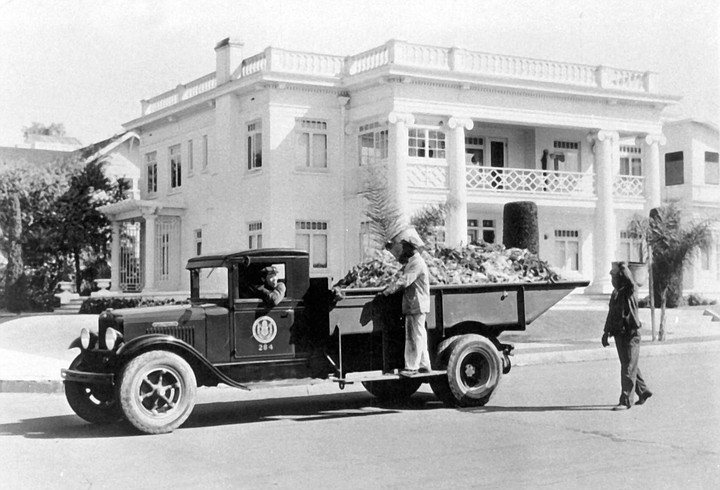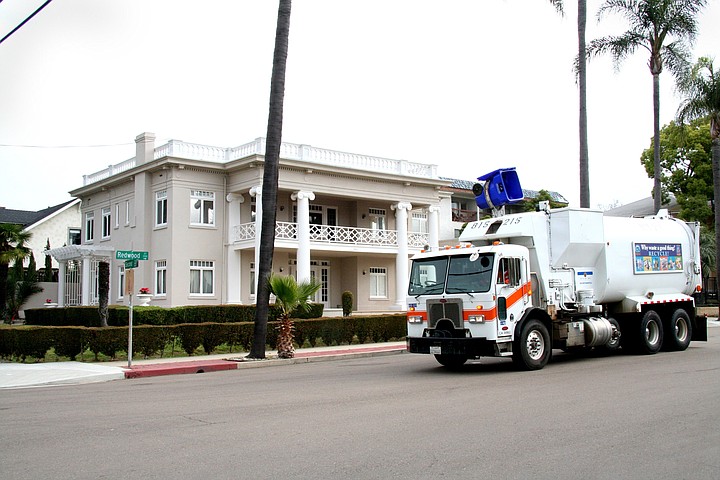 Facebook
Facebook
 X
X
 Instagram
Instagram
 TikTok
TikTok
 Youtube
Youtube

San Diego's automated curbside yard-waste-recycling pilot program expanded to San Carlos in May 2013 when about 5500 green containers were delivered to residents. Last January 7, a woman at the San Carlos Area Council meeting wondered why people at the top of Casselberry Way had containers and those at the bottom of the street didn't.
As this is a somewhat common scenario around the city, I contacted José Ysea, spokesman for the city’s environmental services department, to find out the answer to that question.


Ysea said the primary reason greenery collection hadn't been extended to all homes "is the lack of sustainable funding." Ysea went on to refer to the 1919 People's Ordinance, which legislated free trash pick-up for City of San Diego residents.
A public vote is required to change the ordinance that made the city "responsible for trash collection and for imposing a tax to pay for any costs not covered by proceeds from the sale of hog feed," according to "A History of Waste Management in the City of San Diego."
Ysea said the no-fee arrangement doesn't apply to "many multi-family homes, homes located on private, non-dedicated streets, and those not directly adjacent to a public street”; private franchised haulers serve those residents.
In a recent interview, Ysea said the city provides trash and blue-bin-recycling collection to about 283,000 homes. That's about 55 percent of San Diego’s 512,000 housing units. Approximately 190,000 homes have curbside greenery collection. There's automated pick-up for about 40,000 homes, but "not everyone participates."
Greenery collection and the recycling program are funded by a $10-per-ton fee assessed on trash collected by the city and private haulers. Greenery collection costs $210 per ton; the cost is $100 per ton for trash collection. Yard waste such as grass, leaves, and shrub clippings are taken to the Miramar Landfill and made into mulch and compost.
Curbside greenery collection started in San Carlos during the 1980s, said Ysea. Automation — utilizing collection trucks that do the heavy lifting — began in 1994 with the distribution of black trash containers on wheels. "The city was impressed with the productivity and safety gains and decided to test" automated yard-waste collection.
Green containers were delivered to Tierrasanta in the late 1990s, Ysea said, because anecdotal information indicated the “community represented a small-sized community where different education campaigns could be tested and contrasted for effectiveness."
The last major greenery expansion occurred in 2004 and 2005. Manual collection increased from 120,000 to 180,000 homes. During the past two years, manual collection was added to 6000 homes in portions of Emerald Hills, Paradise Valley, University Heights, City Heights, San Ysidro, and Carmel Valley.
"Neighborhoods with larger lots, mature landscaping, and those who have a record of setting out clean greens [those with little to no contaminants] are good candidates for evaluation when the opportunity for conversion to automated green collection arises."
Other considerations include scheduling and the ability to maneuver trucks on smaller streets and areas with overhead utility lines. Two-person crews do manual collection in rear-loaders, trucks that haul about eight tons; automated one-person packers can cram in about ten tons. Cameras help drivers "with backing and to see the items in the hopper."
Ysea said it would cost an estimated $15 million to automate all current greenery customers: $11 million for containers and $4 million for vehicles. Citywide automation would cost an estimated $14 million for containers and $5 million for vehicles. The landfill's Miramar Greenery processes 90,000 tons of yard waste annually. That total includes about 27,000 tons collected by the city.
Ysea said there are currently "no firm plans" to expand greenery collection or automated pick-up.


San Diego's automated curbside yard-waste-recycling pilot program expanded to San Carlos in May 2013 when about 5500 green containers were delivered to residents. Last January 7, a woman at the San Carlos Area Council meeting wondered why people at the top of Casselberry Way had containers and those at the bottom of the street didn't.
As this is a somewhat common scenario around the city, I contacted José Ysea, spokesman for the city’s environmental services department, to find out the answer to that question.


Ysea said the primary reason greenery collection hadn't been extended to all homes "is the lack of sustainable funding." Ysea went on to refer to the 1919 People's Ordinance, which legislated free trash pick-up for City of San Diego residents.
A public vote is required to change the ordinance that made the city "responsible for trash collection and for imposing a tax to pay for any costs not covered by proceeds from the sale of hog feed," according to "A History of Waste Management in the City of San Diego."
Ysea said the no-fee arrangement doesn't apply to "many multi-family homes, homes located on private, non-dedicated streets, and those not directly adjacent to a public street”; private franchised haulers serve those residents.
In a recent interview, Ysea said the city provides trash and blue-bin-recycling collection to about 283,000 homes. That's about 55 percent of San Diego’s 512,000 housing units. Approximately 190,000 homes have curbside greenery collection. There's automated pick-up for about 40,000 homes, but "not everyone participates."
Greenery collection and the recycling program are funded by a $10-per-ton fee assessed on trash collected by the city and private haulers. Greenery collection costs $210 per ton; the cost is $100 per ton for trash collection. Yard waste such as grass, leaves, and shrub clippings are taken to the Miramar Landfill and made into mulch and compost.
Curbside greenery collection started in San Carlos during the 1980s, said Ysea. Automation — utilizing collection trucks that do the heavy lifting — began in 1994 with the distribution of black trash containers on wheels. "The city was impressed with the productivity and safety gains and decided to test" automated yard-waste collection.
Green containers were delivered to Tierrasanta in the late 1990s, Ysea said, because anecdotal information indicated the “community represented a small-sized community where different education campaigns could be tested and contrasted for effectiveness."
The last major greenery expansion occurred in 2004 and 2005. Manual collection increased from 120,000 to 180,000 homes. During the past two years, manual collection was added to 6000 homes in portions of Emerald Hills, Paradise Valley, University Heights, City Heights, San Ysidro, and Carmel Valley.
"Neighborhoods with larger lots, mature landscaping, and those who have a record of setting out clean greens [those with little to no contaminants] are good candidates for evaluation when the opportunity for conversion to automated green collection arises."
Other considerations include scheduling and the ability to maneuver trucks on smaller streets and areas with overhead utility lines. Two-person crews do manual collection in rear-loaders, trucks that haul about eight tons; automated one-person packers can cram in about ten tons. Cameras help drivers "with backing and to see the items in the hopper."
Ysea said it would cost an estimated $15 million to automate all current greenery customers: $11 million for containers and $4 million for vehicles. Citywide automation would cost an estimated $14 million for containers and $5 million for vehicles. The landfill's Miramar Greenery processes 90,000 tons of yard waste annually. That total includes about 27,000 tons collected by the city.
Ysea said there are currently "no firm plans" to expand greenery collection or automated pick-up.
Comments